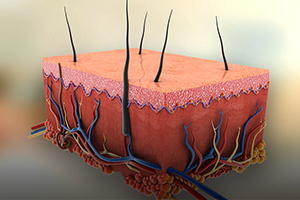Anti-Aging Breakthrough
 A significant breakthrough in understanding the makeup of human skin cells has given researchers a specific biomarker for developing powerful new anti-aging treatments as well as drugs that can address other age-related diseases, including cancer. The discovery was made by taking skin samples from 72 donors, ranging in age from 6 to 72. Samples of the upper layer (epidermis) and lower layer (dermis) were taken from a sun-protected area and analyzed to measure key enzyme activity in the mitochondria. It was found that mitochondrial complex II significantly decreases with age in dermal cells, an observation that had not previously been reported.
A significant breakthrough in understanding the makeup of human skin cells has given researchers a specific biomarker for developing powerful new anti-aging treatments as well as drugs that can address other age-related diseases, including cancer. The discovery was made by taking skin samples from 72 donors, ranging in age from 6 to 72. Samples of the upper layer (epidermis) and lower layer (dermis) were taken from a sun-protected area and analyzed to measure key enzyme activity in the mitochondria. It was found that mitochondrial complex II significantly decreases with age in dermal cells, an observation that had not previously been reported.
The study is important because it shows for the first time that aging can be linked to a specific metabolic enzyme. Over time, decreases in these enzyme levels lead to decreased bio-energy in the skin, causing fine lines, wrinkles and sagging. Armed with this information, it may now be possible to find a treatment, tailored to different ages and skin pigments, to combat the decline and counteract the signs of aging. Additionally, the researchers believe that these results could help address aging processes elsewhere in the body that can lead to any number of age-related disorders.
For information: Mark Birch-Machin, Newcastle University, NE1 7RU, United Kingdom; phone: +44-191-208-5841; email: mark.birch-machin@ncl.ac.uk; website: http://www.ncl.ac.uk